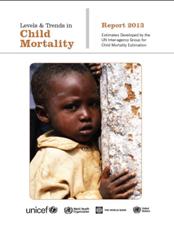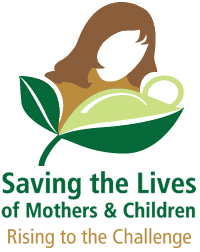Half a million more children’s lives saved in 2012 in the Region
 The IGME updates child mortality estimates annually to monitor progress. Levels and trends in child mortality presents the UN-IGME’s latest estimates of under-5, infant and neonatal mortality and assesses progress towards MDG 4 at the country, regional and global levels.16 September 2013 – 530 000 fewer deaths occurred in children under 5 years of age in 2012 in the Eastern Mediterranean Region compared with 1990, according to a recently released report by the UN Inter-agency Group for Child Mortality Estimation (IGME).
The IGME updates child mortality estimates annually to monitor progress. Levels and trends in child mortality presents the UN-IGME’s latest estimates of under-5, infant and neonatal mortality and assesses progress towards MDG 4 at the country, regional and global levels.16 September 2013 – 530 000 fewer deaths occurred in children under 5 years of age in 2012 in the Eastern Mediterranean Region compared with 1990, according to a recently released report by the UN Inter-agency Group for Child Mortality Estimation (IGME).
Under-5 mortality decreased by 45% in the 22-year period, from 103 to 57 per 1000 live births, at an annual rate of 2.7%. Progress has accelerated from an annual reduction of 2.3% in the decade 1990-1999 to 3.0% in 2000-2009 and 3.3% in 2010-2012. Neonatal mortality declined more slowly by a third (34%) in the same period. In six countries in the Region, the reduction has been greater than the Millennium Development Goal (MDG) 4 target of reducing the under-5 mortality rate by two-thirds between 1990 and 2015. An additional six countries are on track to reach the target by 2015.
Yet, 899 000 under-5 deaths are estimated to occur still in the Region, 46% of them in the first month of life. Most (94%) of the children under-5 who die in the Region die in just 10 countries.
Fifty-nine percent (59%) of the under-5 deaths are caused by prematurity, acute lower respiratory infections, birth asphyxia and trauma, and diarrhoea.
The IGME was established in 2004 to advance the work on monitoring progress towards achievement of MDG 4. WHO is a member of this group, which also includes UNICEF, the World Bank and United Nations Population Division.
Related links
Child mortality estimates - CME Info
Saving the lives of mothers and children: accelerating progress towards achieving MDGs 4 and 5 in the Region
Sudan launches maternal and child health acceleration plan
 29 August 2013 | Sudan’s Federal Ministry of Health together with WHO, UNICEF and the United Nations Population Fund (UNFPA) launched on 28 August 2013 Sudan's National Acceleration Plan for Maternal and Child Health.
29 August 2013 | Sudan’s Federal Ministry of Health together with WHO, UNICEF and the United Nations Population Fund (UNFPA) launched on 28 August 2013 Sudan's National Acceleration Plan for Maternal and Child Health.
Sudan is the first of the 10 high-burden countries in the Region to launch an acceleration plan on maternal and child health, in line with the commitment expressed in the Dubai Declaration, adopted in January 2013.
There has been a significant decrease in the under-5 mortality rate in Sudan, which declined by 33% between 1990 and 2010. The neonatal mortality rate has also decreased by 11% in the same time period.
Related links
Developing maternal and child health (MCH) acceleration plans in the Region, 17–19 June 2013
GAPPD and IMCI: integrated approaches to saving the lives of children
 9 June 2013 – A global initiative named the integrated Global Action Plan for the Prevention and Control of Pneumonia and Diarrhoea (GAPPD) has recently been launched by WHO and UNICEF, calling for integrated approaches to protect, prevent and treat pneumonia and diarrhoea in children under-5.
9 June 2013 – A global initiative named the integrated Global Action Plan for the Prevention and Control of Pneumonia and Diarrhoea (GAPPD) has recently been launched by WHO and UNICEF, calling for integrated approaches to protect, prevent and treat pneumonia and diarrhoea in children under-5.
Pneumonia and diarrhoea remain major causes of death in children under-5 in many developing countries. In the Eastern Mediterranean Region, together they account for 31% of all under-5 deaths, killing some 287 000 children every year. Many of those deaths are preventable and most of them (96%) in the Region occur just in the 10 priority countries which have joined the initiative on Saving the lives of mothers and children, to accelerate progress towards reduction of maternal and child deaths (MDG 4 and 5). Also, pneumonia and diarrhoea are among the most common reasons for health service attendance and hospitalization, with substantial health care cost implications.
The GAPPD is not a return to vertical programmes and does not intend to replace existing integrated strategies such as the Integrated Management of Childhood Illness (IMCI). It is an initiative which aims to catalyse efforts for integrated action across programmes and initiatives. Thus, it lends further support to the implementation of strategies such as IMCI and primary health care approaches promoting the continuum of care.
GAPPD aims to increase the coverage of key, well established, cost-effective interventions within integrated approaches to child survival, including among others such interventions as:
Exclusive breastfeeding for six months and continued breastfeeding with appropriate complementary feeding, vitamin A supplementation;
Appropriate care of pneumonia and diarrhoea in the community and at health facilities (as per the IMCI guidelines);
Use of vaccines against measles, pertussis, Haemophilus influenzae type b (Hib) and, more recently, Streptococcus pneumoniae (Pneumococcus) and rotavirus;
Water, sanitation and hygiene interventions, including access to and use of safe drinking-water and sanitation, as well as promotion of key hygiene practices;
Reduction of household air pollution with improved stoves.
IMCI addresses pneumonia and diarrhoea within its integrated strategy and GAPPD reinforces such an approach.
The GAPPD key message is that no single intervention can effectively prevent, treat or control either pneumonia or diarrhoea. The introduction of new vaccines in a country, such as pneumococcal conjugate vaccine and rotavirus vaccine, will be contributing to reducing pneumonia and diarrhoea deaths in under-5 children. It also offers an opportunity to promote the development of a comprehensive plan with other interventions to prevent and control pneumonia and diarrhoea deaths among under-5 children to maximize impact. In fact, only 28% of fatal diarrhoeal cases are associated with rotavirus and 33% of pneumonia deaths are associated with Streptococcus pneumoniae, respectively, and the estimated potential vaccine effectiveness is 30% for Streptococcus pneumoniae and 74% for rotavirus. This means that only a coordinated, integrated plan to deliver a package of interventions would achieve the most benefits.
The GAPPD sets ambitious targets to reduce mortality rates by 2025 and raise levels of children’s access to life-saving interventions.
To date, two countries in the Region (Somalia and Sudan) have developed plans for GAPPD within the framework of integrated child care.
A new Lancet series on childhood pneumonia and diarrhoea has been released at the time GAPPD has been launched, providing the evidence base for integrated action on these two illnesses, including epidemiological data, effective interventions and the financial cost of ending preventable deaths from childhood diarrhoea and pneumonia by 2025.
Related links
Pneumonia: the forgotten killer of children
Diarrhoea: why children are still dying and what can be done
Pneumonia and diarrhoea: Tackling the deadliest diseases for the world’s poorest children, UNICEF


